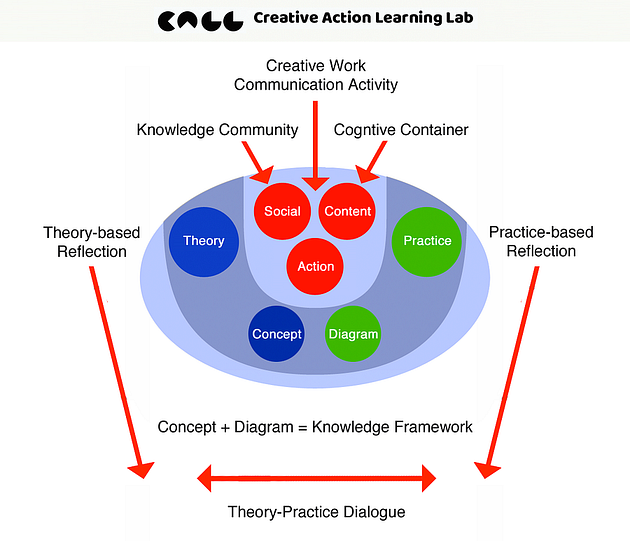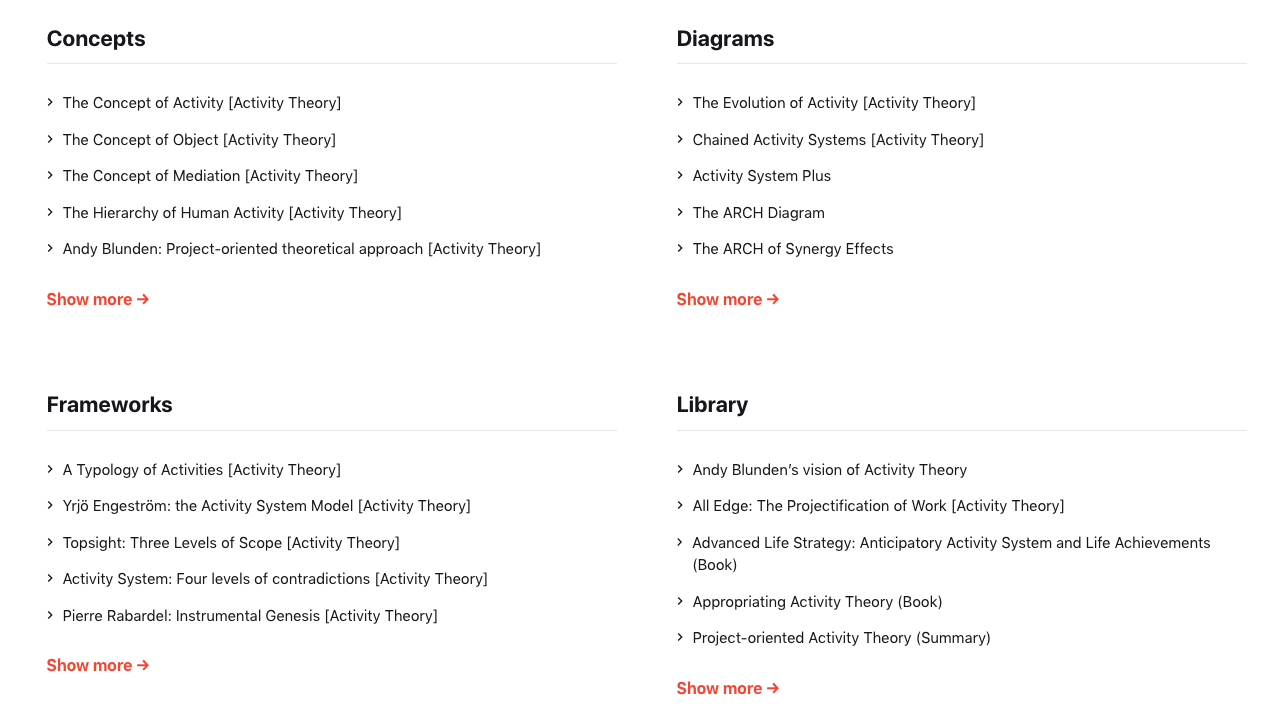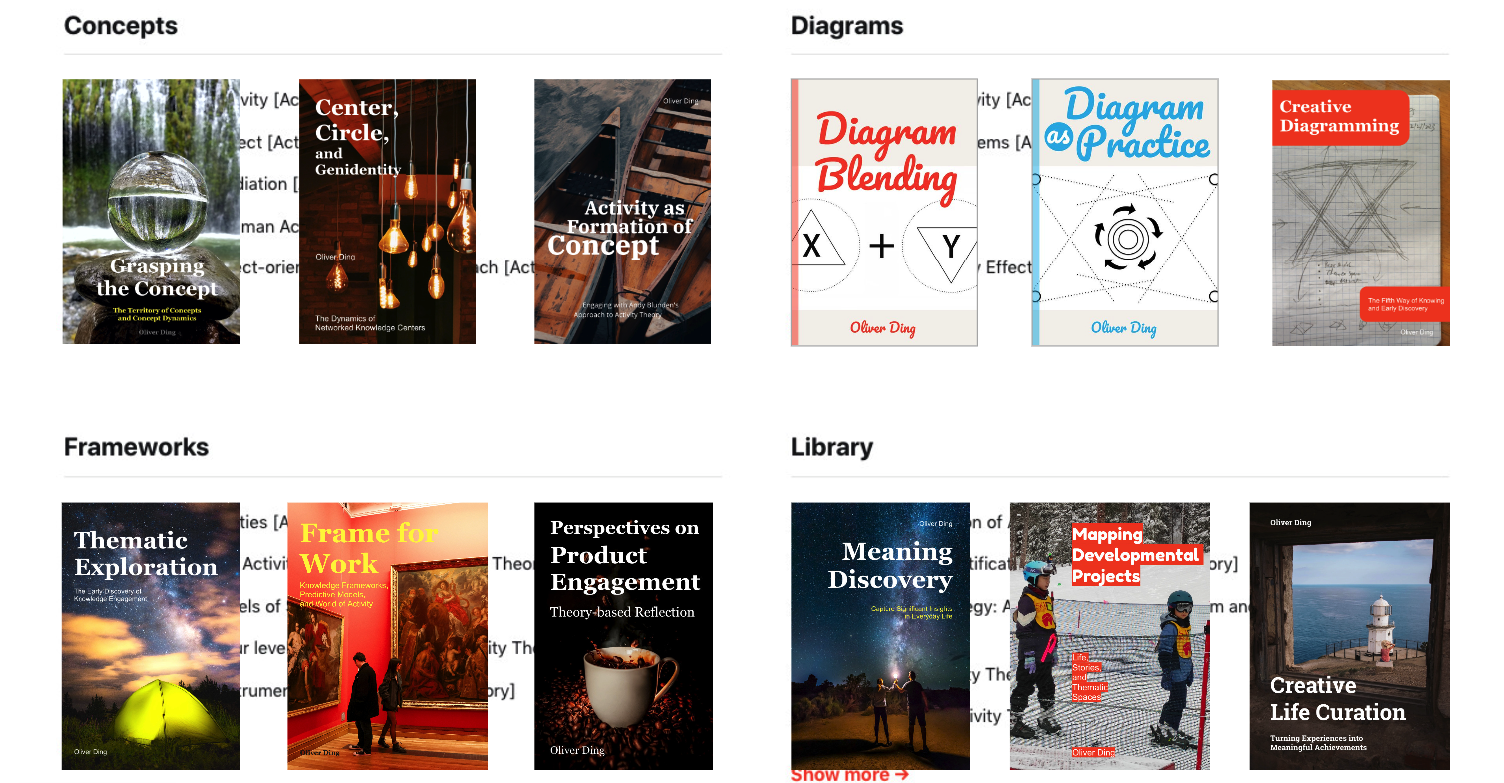Activity Analysis Network #4: Theory, Practice, and Diagrams

This is the 4th issue of the Activity Analysis Center's newsletter
by Oliver Ding
Hi, and welcome to Activity Analysis Network, a newsletter hosted by the Activity Analysis Center.
Each issue is organized around the "Flow - Focus - Center - Circle" schema, the primary model of the World of Activity Toolkit (v1, 2025).
As a biweekly newsletter, I'll share summaries of new articles from the Activity Analysis Center, along with updates on related activities, including some of my own published work elsewhere.
In this issue (#4), many of the new articles explore diagrams as tools for both theory and practice, drawing on Lev Vygotsky's concept of psychological tools for mediating action. The featured diagram (see above) frames my three-year journey (2019–2021) connecting theory and practice. The FLOW section will share this story in detail.
Flow
The historical development of the Activity Analysis Center and my experience of daily life
In August 2019, I read several academic papers centering on a debate between Jim Garrison, a philosopher and Dewey scholar, and Reijo Miettinen, an Activity theorist and Vygotsky scholar. They discussed the relationship between Deweyan pragmatism and cultural-historical activity theory, which was founded by the Soviet psychologist Lev Vygotsky.
Garrison argued that Activity Theory adopts a dualist approach due to its distinction between the internal and the external. He suggested that Dewey’s transactional theory of action offers a better framework for understanding human activity. Miettinen disagreed, claiming that Activity Theory is just as committed to anti-Cartesian monism as Dewey’s conception. He also argued that Activity Theory provides useful conceptual tools for transcending the dualism between the internal and the external.
This reading experience inspired me to create the WXMY diagram. Version 1.0 used the terms “Camp X,” “Camp Y,” and “Camp Z” because it initially focused on social groups. Later, I expanded the model to include any kind of entity, so I replaced the term “Camp” with “Container.”

This simple diagram guided my three-year journey of the Theory-Practice connection. In the latest issue of the Appropriating Activity Theory series, I shared this story in more detail.
Focus
The Thematic Foci of the Activity Analysis Center
Over the past few years, I have worked on connecting theory with practice and developing knowledge frameworks. Eventually, I also studied how theorists develop their theories.
While theorists always deal with abstract ideas, what they do can be considered a type of activity. I call this special type of activity Theoretical Activity, which encompasses activities such as building theories, theoretical curation, theory integration, and theorizing.
I also distinguish between the individual cognitive level of theoretical projects and the collective, collaborative level involved in building a theoretical enterprise. Both levels belong to Theoretical Activity.
On October 19, 2025, I created the Weave-the-Theory framework to discuss Theoretical Activity.

More details can be found in Creativity, Curativity, and Theoretical Activity.
CENTER
The Core of the Activity Analysis Center
One year ago, I redesigned the logo of the Activity Analysis Center. The new logo draws inspiration from the AAI diagram and incorporates double circles: a red circle to represent Activity and a blue circle to represent Knowledge.

This updated logo conveys an essential message: the Activity Analysis Center is not only about Activity Theory but also about the Knowledge behind Activity.
Over the past two weeks, the Activity Analysis Center website has undergone a strategic transformation.
The current site structure was originally designed in 2022, when categories such as Concepts, Diagrams, Frameworks, and Library were all intended for publishing content related to Activity Theory.

However, this content policy has recently been updated. While these categories remain, the focus of each has shifted toward exploring the concepts themselves:
- Concepts: articles about concept development, concept formation, concept dynamics, etc.
- Diagrams: articles about diagram blending, diagramming as practice, creative diagramming, etc.
- Frameworks: articles about the theme-concept-framework transformation, and frameworks for projects, etc.
- Library: articles about my 42+ not-yet-published book drafts.

This new content policy also represents my creative focus over the past several years:
- The Knowledge Engagement activity
- The Developing Tacit Knowledge activity
- The Theoretical Activity
- The Life Discovery Activity
Over time, I have developed a series of concepts, diagrams, and frameworks related to these activities, and I have written a series of book drafts. More of this content will be gradually published on the Activity Analysis Center website.
New articles:
- The Geometry of the Activity System Model
- The Dialectic Room: A Meta-diagram for Innovation
- The Dialectic Room: Theoretical Foundations
- The Mapping Strategic Moves Method (v1, 2024)
- Strategic Life Narrative (Possible Book, v1, 2025)
- Frame for Work (Possible Book, v1, 2024)
- Knowledge Discovery (Possible Book, 2022)
CIRCLE
The Context of the Activity Analysis Center
Over the past several years, I worked on several theoretical projects, such as the Ecological Practice Approach, Curativity Theory, Creative Life Theory, and Thematic Space Theory.
Inspired by creativity researcher Howard Gruber's idea of "Network of Enterprises," I used the "Knowledge Center" approach to manage this large knowledge system. Each knowledge center hosts one or two related theoretical approaches.
- CALL (Creative Action Learning Lab): the Ecological Practice Approach and Creative Life Theory
- Curativity Center: Curativity Theory
- TALE (Thematic Analysis Learning Engagement): Thematic Space Theory
- Frame for Work: A theory about Knowledge Frameworks
Within the past two weeks, I wrote several new articles presenting new ideas based on Weave diagrams. See the links below:
- Creative Life Coordinate (2025)
- [Meta-framework] The Birth of the “Self-Us-Awe” Schema
- Attachance Theory: The “Weave the Whole” Framework
- The Weave-the-Mind Framework
- Weave the Concept: Mental Elements, Mental Models, and Mental Platform
World
Me, You, and We

My name is Oliver Ding. I am the founder of the Activity Analysis Center. I am based in Houston, Texas, US.
Where are you?
v1.0 - October 31, 2025 - 983 words
